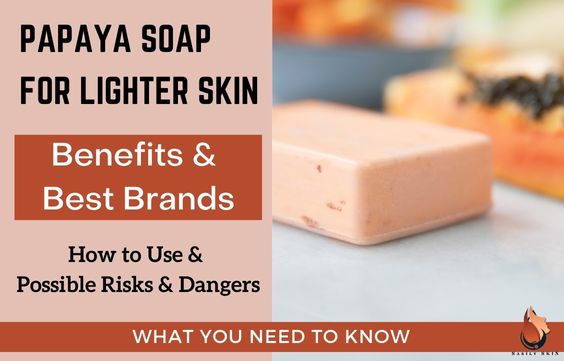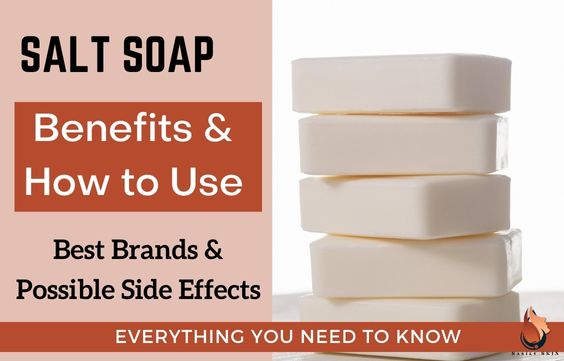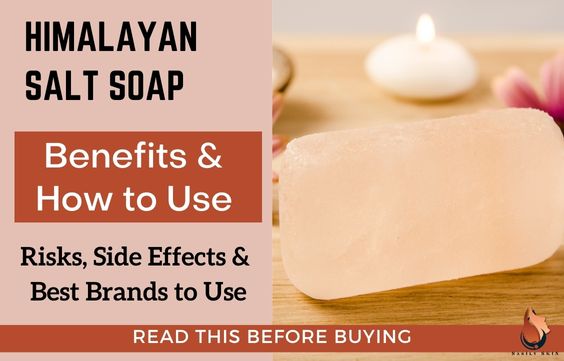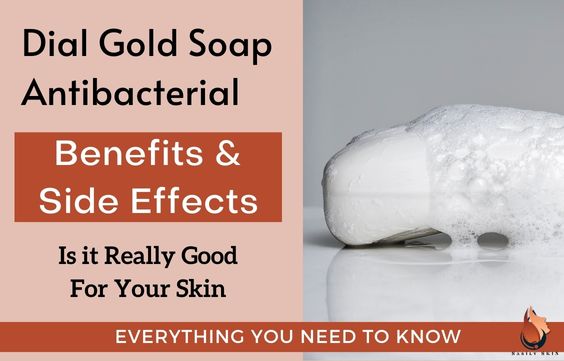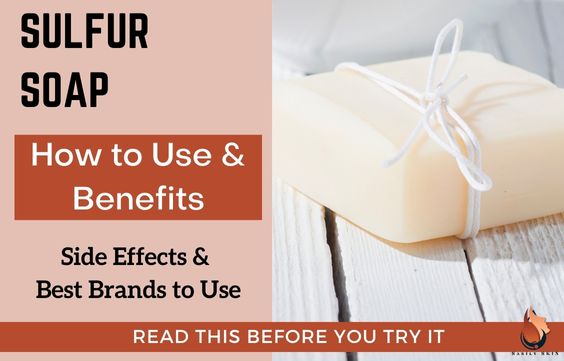Best Salicylic Acid Soaps – Benefits, Risks & How To Use
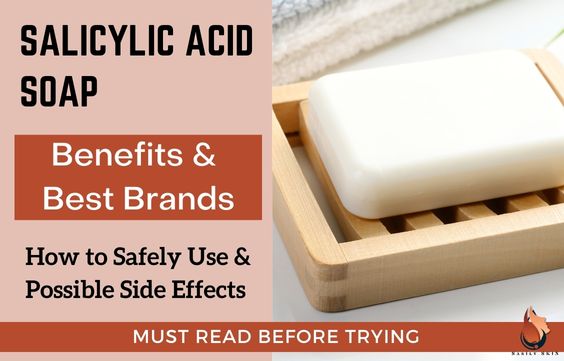
Salicylic Acid is a bestie for those who are acne-prone or have “bumpy” skin. It can be used on the skin as a serum, as a cleanser, in creams, etc. But what about Salicylic acid soaps?
That’s right, I’m talking about bar soap. What are the benefits of salicylic acid bar soap over other salicylic acid formulations, and how do you properly use it for maximum results?
Reminder: What is Salicylic Acid
Salicylic acid is a beta hydroxy acid (BHA) that is derived from willow bark.
Its chemical structure makes it fat and oil-soluble so it easily penetrates the pores of the skin and gets across the lipid barrier of your skin (deep into the skin).
Because of its deep-penetrating action, it works well to clean the pores and get rid of deep impurities and oil clogs while exfoliating the skin.
Video: Salicylic Acid – What it is, how it Works, and its benefits on Skin
Benefits Of Salicylic Acid Soap
The salicylic acid in soaps will:
- Be great for acne – Blackheads, whiteheads, or pustules (pustules) frequently develop when your hair follicles (pores) become clogged with oil and dead skin cells. They can also become infected with bacteria. Salicylic acid penetrates deep into the pores and dissolves the built-up oil, dead skin cells, and debris. It also has some antibacterial properties. This helps to manage and treat acne breakouts.
- Reduce Inflammation – salicylic acid has anti-inflammatory properties that help to soothe redness, swelling, pain, and irritation. This can be especially helpful for acne-prone skin. Acne lesions often become swollen, red, and painful on the skin when inflamed.
- Exfoliate the skin – other than getting rid of dead skin cells inside the pores, salicylic acid also loosens up and lifts away the top layer of skin cells all over where it is applied. This action results in it being known as a keratolytic agent – meaning that it softens and sloughs off skin cells.
- Reduce oil secretion – since salicylic acid is lipid and oil soluble, it dissolves the excess oil that is secreted in the skin. This makes the skin less prone to clogged pores and acne. Click here to read more about Salicylic Acid For Oily Skin – What You Need To Know.
- Help to even skin tone – constant exfoliation will eventually help to even out your skin tone in areas that have mild to moderate hyperpigmentation and scars.
Other great soaps similar to salicylic acid soap:
Benzoyl Peroxide Soap: Benefits, Side Effects & Best Ones
Glycolic Acid Soap- Benefits, Risks, How to Use & Best Ones
Sulfur Soaps- Benefits, Side Effects, How to Use & Best Brands
How To Use Salicylic Acid Soaps
Salicylic acid soaps can be used all over your skin or on specific “problem” areas depending on the condition of your skin.
Choosing the right salicylic acid soap
Most experts and skin professionals recommend using salicylic acid gradually so that your skin can get used to the treatment.
This means starting with the lowest concentration that is effective for your skin. Most salicylic acid soaps available today contain anywhere between 0.5% to 3% of salicylic acid. This is just enough to be used on your skin regularly without irritating it while still giving you results.
If you have never used salicylic acid before, I recommend that you consult your dermatologist or skincare professional so that they can assess your skin. They will help you to determine what starting concentration would be best for you.
Related Articles –
Salicylic Acid For Dark Underarms & Odor: What to Know
5 Best Soaps to Lighten Dark Underarms, Necks & Thighs
When to use Salicylic Soap
Depending on how strong your salicylic acid soap is, and how your skin tolerates the treatment, your soap can be used in the morning, at night, or both.
I do not recommend using this just before you go out in the day and in the sun as it can make your skin more sensitive to UV rays and sunburn. However, if you need to use it and you have to go out, always wear your SPF.
Using it at night is a great option, especially if you are only using it once a day. I love to use salicylic acid soap at night just before my skincare routine and before bed. My skin gets a chance to absorb my products (like salicylic acid) and relax as I wind down for the night.
Related Articles –
Best Salt Soap – Benefits, How to Use & Side Effects
Himalayan Salt Soap – Benefits, Side Effects & Best Ones
How often to use Salicylic Soap
How often you will need to use your salicylic acid soap will depend on the condition of your skin and how your skin tolerates the treatment.
Dermatologists generally recommend that you start by using salicylic acid 1-2 times per week. See how your skin will react for a few weeks and whether you see any positive differences in your skin. Then, if your skin can tolerate it, gradually increase how often you use it.
Remember that you may get some purging, which can look like acne or flare-ups, but is normal. It goes away after 4-6 weeks. If it does not go away, then it may be an acne flare-up or irritation. If that is the case, lessen the concentration and/or frequency of use.
It will take your skin at least 4-6 weeks (one skin cycle) to show significant changes from using salicylic acid, especially in areas where you do not have active acne lesions.
Related Articles –
Best Kojic Acid Soaps- Benefits, Side Effects & How to Use
Oatmeal Soap Benefits- Can It Help Eczema & Psoriasis
Ginger Soaps- Benefits, Side Effects & Do They Really Work
Aftercare
After using salicylic acid soap, it is best to moisturize your skin with a moisturizer that will not block your pores, especially if you are acne-prone.
This will help to keep your lipid barrier healthy and replace some of the moisture lost during the exfoliation process when using salicylic acid.
It will also prevent irritation in the skin that can result when the skin becomes too dry.
Click here to read more about Moisturizing After Salicylic Acid: What To Do & Use.
Related Articles:
Best Vitamin C Soaps -Benefits, Side Effects & How to Use
Vitamin E Soaps- Benefits, Uses & Side Effects
Best Papaya Soaps for Lighter Skin- Benefits & Side Effects
Carrot Soaps- Benefits, Side Effects & Best Ones to Use
Best Salicylic Acid Soaps To Use
1- 111MedCo 2% Salicylic Acid Cleansing Soap Bar
This soap bar is recognized by the FDA and they have the label and product information listed in detail on their sites for the treatment of acne.
Many people who have used it reported that it works great for their skin. Some of them have reported experiencing some irritation but that could be due to overuse or sensitive skin.
The main active ingredient is 2% salicylic acid.
You can Click here to see the 111MedCo 2% Salicylic Acid Cleansing Soap Bar on Amazon.
2- Dermaharmony 2% Salicylic Acid Natural Soap
This carefully developed 2% Salicylic Acid bar soap clears acne without undue drying or irritation.
If you usually get whiteheads, blackheads, sweat acne, pimples, pustules, papules, cysts, pittosporum folliculitis, cystic acne, and nodules, you ought to get this soap.
All skin types can benefit from using this soap, which is suitable for daily use by both adults and children. The company also claims that the FDA has approved this medication as an over-the-counter (OTC) treatment for acne.
You can Click here to get the Dermaharmony 2% Salicylic Acid Natural Soap on Amazon.
3- CeraVe SA Cleanser Bar for Rough & Bumpy Skin
CeraVe SA bar is a great option if you have rough and bumpy skin or mild acne. It provides both chemical and physical exfoliation along with barrier-reinforcing ingredients like ceramides.
To gently sweep away dead skin cells and improve the appearance and feel of rough, bumpy skin, this soap-free bar uses a combination of physical exfoliation with spherical jojoba beads and chemical exfoliation with salicylic acid.
In addition to completely cleansing the face and removing dirt and oil, this product’s formulation softens and smoothes skin without compromising the skin’s natural protective layer or making it feel tight or dry.
You can Click here to check out the CeraVe SA Cleanser Bar on Amazon.
Side Effects of Salicylic Acid Soaps
The most common side effects associated with using salicylic acid on the skin, in the form of soap or any other form, include purging, irritation, and allergic reactions.
Skin Purging
Skin purging happens when an active ingredient (like salicylic acid) pushes dead cells, debris, oil, and other gunk from your pores up toward the surface of your skin to get rid of it at a faster rate than your skin usually regenerates its layers.
This can result in bumps that look and almost feel like acne, but it isn’t. It usually goes away after a few weeks, then you begin to see the true effects of Salicylic acid on your skin.
Click here to read more about Skin Purging from Salicylic Acid: How to Spot & Treat.
Irritation
Using salicylic acid too often, or using a concentration that is too strong for your skin can cause skin stripping – meaning that it will strip the moisture and healthy factors out of your skin along with all the bad stuff.
This will make your skin dry and can result in bumps, swelling, redness, and even worsening acne as the skin starts to overproduce oils to compensate for the dryness.
A great way to combat irritation from salicylic acid, apart from modifying the frequency of use and the concentration, is to moisturize your skin well. Click here to read more about Moisturizing After Salicylic Acid: What To Do & Use.
Allergic Reactions
While allergic reactions to salicylic acid are rare, they are still a possibility.
Generally, allergic reactions look like flat, red bumps (hives) or peeling, but sensitivity reactions can also resemble acne pustules.
In worse cases, you can experience dizziness, difficulty breathing, and confusion.
If you start to feel any of these symptoms, seek medical attention right away.
Related Article – Can You Use Salicylic Acid Under the Eyes – Shocking Truth
Sources
What Is Salicylic Acid and How Does It Benefit Skin? | Allure
Salicylic Acid for Acne: Benefits, Dosages, and Side Effects
Salicylic Acid | HOC6H4COOH | CID 338 – PubChem
Benefits of Salicylic Acid: It Fights Acne, Removes Dead Skin Cells and More – MYSA

